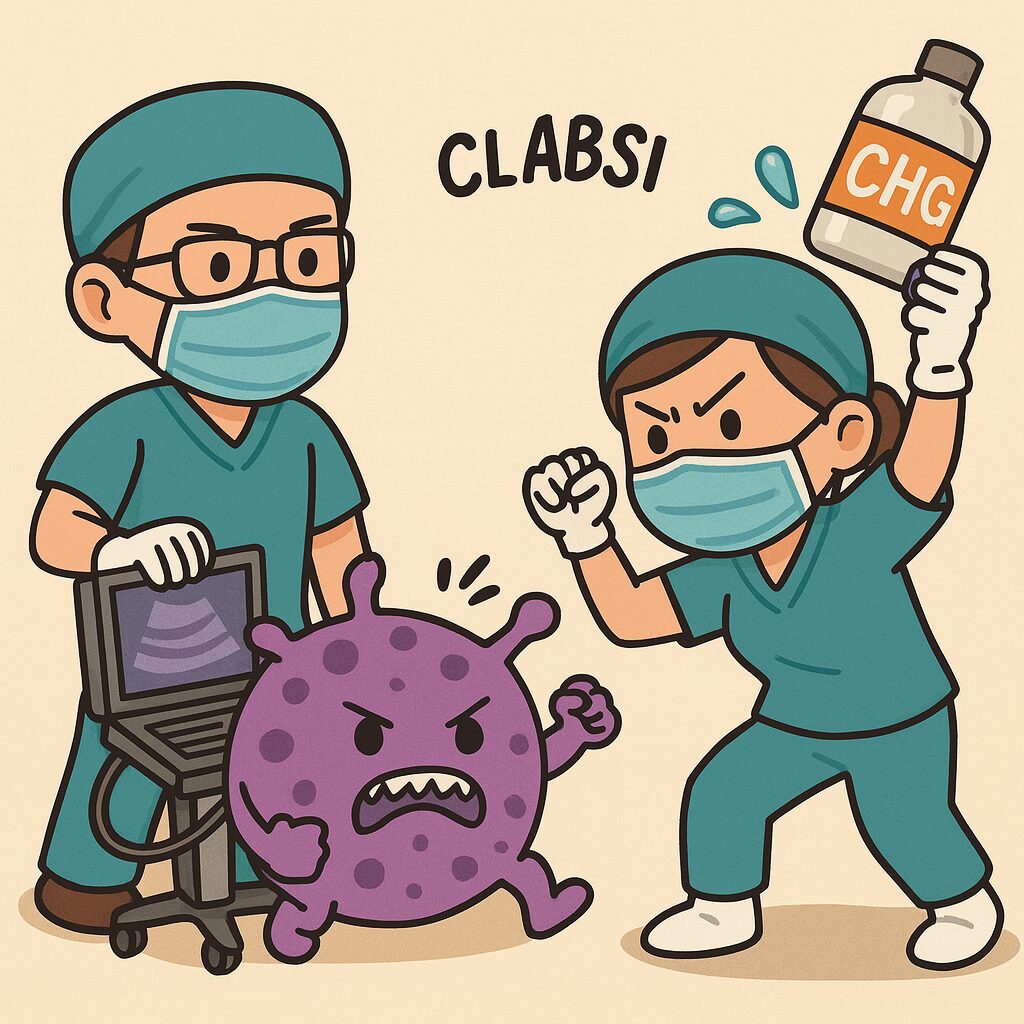👉👉 🇺🇸 All Posts 🇬🇧 / 🇯🇵 記事一覧 🇯🇵 👈👈
🩺 Are We Really Preventing CLABSI?
 まっすー
まっすー“We haven’t had any central line infections recently.”
“I always use ultrasound, so it should be fine.”
“We change CHG dressings every week and keep hubs capped!”
Sounds familiar?😊
Let’s review the essentials together — from terminology and risk factors to evidence-based prevention bundles and ultrasound safety☝️


♦️ CLABSI vs. CRBSI — What’s the Difference?
These two terms are often used interchangeably but mean different things:
- CLABSI (Central Line–Associated Bloodstream Infection)
A surveillance definition used for hospital quality monitoring.
It refers to a bloodstream infection occurring within 48 hours of central line placement, with no other identifiable source. - CRBSI (Catheter-Related Bloodstream Infection)
A clinical diagnosis that confirms the catheter as the infection source — typically by differential time to positivity or quantitative culture of catheter and peripheral blood samples.
♦️ How Common Is CLABSI Today?
In the United States, rates have fallen dramatically to about 0.8 per 1,000 catheter-days — roughly one infection for every 1,200 central-line days (≈0.08%).
That’s one of the success stories of infection prevention.
In contrast, low- and middle-income countries (LMICs) still report higher rates — around 4.5 per 1,000 catheter-days (INICC, 2015–2020).
A large Chinese meta-analysis found a pooled rate of 2.65 per 1,000 catheter-days (2.57 in adults, 3.12 in pediatric ICUs).
♦️ Risk Factors — and What We Can Change
It helps to distinguish modifiable from nonmodifiable risks.
🔹 Modifiable (focus here!)
- Prolonged catheterization:
≥5 days (OR 2.1), ≥7 days (3.6), ≥14 days (4.8).
→ Daily review of necessity is essential. - Multiple lumens: OR 3.4 — use the fewest possible.
- Femoral site: OR 2.4 — avoid if feasible.
- TPN administration: OR 2.3 — minimize disconnections.
- Repeated insertions: OR 3.5 — succeed on the first attempt with training and ultrasound.
🔹 Nonmodifiable (but manage carefully)
- Long ICU stay (OR 4.0)
- Older age (≥60 y; OR 2.2)
- Diabetes (OR 3.1)
- Immunosuppression (OR 2.9)
✅ Core Prevention Bundle (CDC / SHEA / WHO Consensus)
🔷 Before Insertion
- Assess indication daily; remove if unnecessary.
- Ensure staff are trained and competency-verified.
🔷 During Insertion
- Hand hygiene with alcohol-based rubs.
- Maximal sterile barrier precautions: cap, mask, sterile gown & gloves, full-body drape.
- Skin antisepsis: ≥0.5% CHG in alcohol, allow complete drying.
- Site selection:
- Prefer subclavian > internal jugular > femoral in adults (infection perspective).
- Avoid femoral whenever possible.
- Avoid subclavian in patients with advanced renal disease (risk of subclavian stenosis affecting future dialysis access).
- Ultrasound guidance reduces failed attempts and mechanical complications — but must preserve sterility (sterile probe cover, gel).
- Use the fewest lumens necessary.
🔷 After Insertion (Maintenance)
- CHG-impregnated dressings for adults;
replace transparent dressings every ≤7 days (sooner if damp or loose), gauze every 2 days. - Hub disinfection: scrub with alcohol or use alcohol-impregnated disinfecting caps as adjuncts.
- Tubing replacement: every ≤7 days (except blood/fat emulsions).
- Daily review: if no longer needed → remove immediately.
- Surveillance and feedback: track CLABSI rates and adherence.
✅ These alone can reduce infection rates by more than half when consistently applied.
♦️ Additional / Selective Measures
- Antimicrobial or antiseptic-coated catheters
(e.g., CHG–silver sulfadiazine, minocycline–rifampin): effective in high-risk settings or recurrent CLABSI. - Antimicrobial lock therapy
For long-term catheters or recurrent CLABSI when removal is not feasible.
— Uses antibiotic or antiseptic solution (e.g., minocycline/EDTA) instilled into the catheter lumen between uses.
— Ethanol lock can be effective but requires caution due to risks of catheter damage, thrombosis, and systemic absorption. - Disinfecting hub caps
(alcohol-filled single-use caps such as SwabCap®, Tegaderm™ Disinfecting Cap) help reduce hub contamination by maintaining continuous disinfection.
— Considered an adjunct, not a replacement for manual scrubbing.
♦️ Complications (Beyond Infection)
🔷 Mechanical complications:
Arterial puncture, hematoma, pneumothorax, hemothorax, cardiac tamponade, air embolism, arrhythmia, nerve injury.
🔷 Air embolism during removal:
Cover the site with an air-occlusive dressing and maintain proper patient positioning.
🔷 Ultrasound-Guided Insertion — Safe by Design
- Multiple RCTs and meta-analyses show:
- Fewer attempts, fewer arterial punctures, fewer pneumothoraces, and higher success rates.
It doesn’t directly reduce infection, but indirectly improves safety and efficiency.
Key: sterile probe cover, sterile gel, real-time imaging.
📝 Summary:Take Home Points
- CLABSI and CRBSI serve different purposes — don’t mix them.
- Global CLABSI rates are dropping, proving that adherence to bundles works.
- Main risks are modifiable: line days, lumen number, femoral site, and TPN.
- The prevention bundle is non-negotiable:
- Hand hygiene
- Maximal sterile barrier
- Alcohol–CHG skin prep
- CHG dressing + hub disinfection
- Daily line review → prompt removal
- Ultrasound is your safety tool, not just a convenience.
- Avoid subclavian in renal failure patients to preserve future dialysis access.
- Disinfecting caps and antimicrobial locks are useful adjuncts — apply selectively.
- Team consistency beats individual skill. Sustained adherence lowers infection rates everywhere.
📚 References & Further reading
- CDC: Strategies for Prevention of Catheter-Related Infections (2024)
- WHO Guidelines for the Prevention of Bloodstream Infections and Related Events (2024)
- SHEA/IDSA: Strategies to prevent CLABSI in Acute Care Hospitals (2022)
- PMC: Guidelines for the Prevention of Intravascular Catheter-Related Infections
- ScienceDirect: Systematic review of CLABSI prevention (2024)
- Frontiers in Public Health: Meta-analysis of CLABSI rates in ICUs (2025)
- PLOS ONE: Risk factors for CLABSI (2024)
- PubMed: Systematic review and meta-analysis of CLABSI risk factors (2023)
🔗 Related articles
- to be added

コメントを投稿するにはログインしてください。